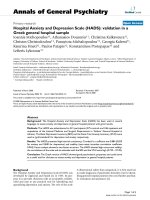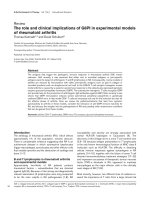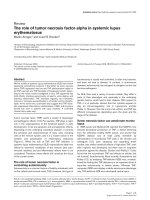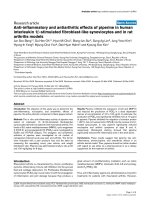Báo cáo y học: " Aging, osteoarthritis and transforming growth factor-β signaling in cartilage" pps
Bạn đang xem bản rút gọn của tài liệu. Xem và tải ngay bản đầy đủ của tài liệu tại đây (36.86 KB, 2 trang )
Page 1 of 2
(page number not for citation purposes)
BMP = bone morphogenetic protein; C-Smad = common Smad (Smad 4); IL = interleukin; LAP = latency-associated protein; MH = Mad homology
domain in the Smads; R-Smad = receptor-activated Smad (Smads 2 and 3 for TGF-β signaling; Smads 1, 5 and 8 for BMP signaling); Smad = a
composite term derived from Sma genes from Caenorhabditis elegans and Mad gene (Drosophila melanogaster) involved as intracellular substrate
for TGF-β and BMP signaling; TGF-β = transforming growth factor-β.
Available online />Abstract
Osteoarthritis is a common malady of the musculoskeletal system
affecting the articular cartilage. The increased frequency of osteo-
arthritis with aging indicates the complex etiology of this disease,
which includes pathophysiology and joint stability including
biomechanics. The balance between anabolic morphogens and
growth factors and catabolic cytokines is at the crux of the problem
of osteoarthritis. One such signal is transforming growth factor-β
(TGF-β). The impaired TGF-β signaling has been identified as a
culprit in old mice in a recent article in this journal. This
commentary places this discovery in the context of anabolic and
catabolic signals and articular cartilage homeostasis in the joint.
It is common knowledge that with aging one confronts the
generally inevitable pain in the joints that limits mobility as a
result of osteoarthritis. Osteoarthritis is characterized by
articular cartilage damage and the resultant repair response
including osteophyte formation and joint capsule thickening.
The etiology of osteoarthritis remains unknown. At steady
state the homeostasis and response of articular cartilage is
determined by the exquisite control of the cells and extra-
cellular matrix by anabolic morphogens and catabolic cyto-
kines [1]. The aim of this commentary is to place in context a
recent article in this journal of anabolic growth factor, trans-
forming growth factor-β (TGF-β) signaling in articular cartilage
in aging mice [2]. This commentary will discuss TGF-β
signaling and osteoarthritis in an experimental investigation in
the mouse. It is important to bear in mind that results obtained
in mice may not be directly extrapolated to humans.
TGF-β is a secreted homodimeric pleiotropic protein
regulating proliferation, migration, differentiation, and death in
a variety of cell types including articular chondrocytes in the
joint. There are three isoforms of TGF-β, designated TGF-β
1
,
TGF-β
2
, and TGF-β
3
, in mice and humans. TGF-β isoforms
have wide-ranging roles in the development, maintenance
and homeostasis of articular cartilage along with related bone
morphogenetic proteins (BMPs). In several human diseases
such as autoimmunity, cancer, and fibrosis, there is a
perturbation of TGF-β signaling [3,4]. The related BMPs have
fundamental roles in the lineage, morphogenesis, maintenance,
and homeostasis of articular cartilage [5,6].
The members of the TGF-β family bind to a heteromeric
receptor complex on the cell surface and activate an
intracellular signal transducing the Smad complex (a
composite term derived from Sma genes from Caenorhabditis
elegans and Mad gene (Drosophila melanogaster) involved as
intracellular substrate for TGF-β and BMP signaling). The
receptor complex initiating the TGF-β response consists of
two type II and two type I TGF-β receptors. These receptors
are transmembrane serine/threonine protein kinases. The
receptor protein kinases phosphorylate the cytosolic Smads 2
and 3, which are also referred to as R-Smads and receptor-
activated Smads. Phosphorylation of Smads 2 and 3 results in
a conformational change and permits interaction with a
common Smad (C-Smad) and initiates the translocation into
the nucleus. In the nucleus they act in collaboration with
sequence-specific transcription coactive factors to initiate and
regulate gene expression.
The Smads are intracellular signaling complexes and consist
of TGF-β receptor-activated R-Smads (such as Smads 2 and
3), a common partner Smad (C-Smad; also known as
Smad 4) and inhibitory Smads (Smads 6 and 7). The
Commentary
Aging, osteoarthritis and transforming growth factor-
ββ
signaling
in cartilage
A Hari Reddi
Lawrence J Ellison Center for Tissue Regeneration, University of California, Davis, School of Medicine, Sacramento, CA 95817, USA
Corresponding author: A Hari Reddi,
Published: 28 November 2005 Arthritis Research & Therapy 2006, 8:101 (doi:10.1186/ar1858)
This article is online at />© 2005 BioMed Central Ltd
See related research by Davidson et al. in issue 7.6 [ />Page 2 of 2
(page number not for citation purposes)
Arthritis Research & Therapy Vol 8 No 1 Reddi
R-Smads and the C-Smad have a highly conserved Mad
homology domains (MH 1 in the amino terminus and MH 2 in
the carboxy terminus).
Binding of the TGF-β isoforms to the TGF-β receptors
(TGF-βRs) results in the recruitment and phosphorylation of
R-Smads by type I TGF-βR (also known as activin receptor-
like kinase-5, or ALK-5). A trimeric complex of two R-Smads
and one common Smad, Smad 4, is translocated from the
cytoplasm into the nucleus to act as transcription factors [3,4].
In the article published recently in Arthritis Research and
Therapy [2], the authors examined TGF-β in the knee joints of
mice aged 5 months or 2 years. The mice were challenged
with IL-1 to initiate cartilage catabolism. The authors examined
the response of the articular cartilage to TGF-β
1
as an
anabolic factor that can counteract the actions of catabolic
cytokine IL-1. To gain insights into the cell types and cellular
compartments, immunocytochemical methods were employed.
TGF-β isoforms 1, 2, and 3, TGF-β receptors I and II, Smads
2, 3, 4, 6, and 7, and phosphorylated Smad 2 (Smad-2P)
were localized in the joints of young and old mice. In 2-year-
old mice there was a decline in the expression of TGF-β
2
,
TGF-β
3
and TGF-β receptor. It is noteworthy that the number
of cells expressing phosphorylated Smad 2 decreased in old
mice. In addition, blockade of TGF-β signaling by the latency-
associated protein (LAP) delivered by an adenoviral vector
was employed. The LAP attenuated the loss of proteoglycan in
response to treatment with IL-1. This indicates that the TGF-β
signaling induced as a repair response to IL-1 is curtailed by
TGF-β depleting LAP. The LAP binds to TGF-β and prevents
its bioavailability to the receptors.
Although it is clear that TGF-β-mediated anabolic signaling is
an important aspect of joint homeostasis, future studies need
to focus on members of the BMP family such as BMP-2,
BMP-7, and growth differentiation factor 5 (GDF-5). GDF-5 is
also known as cartilage-derived morphogenetic protein 1
(CDMP 1) and has been implicated in articular cartilage
development and maintenance [6,7].
Conclusion
Continued investigations of the articular cartilage homeostasis
and regeneration are likely to suggest novel therapeutic
approaches to the amelioration of the horrendous, painful
consequences of osteoarthritis in aging humans.
Competing interests
The author(s) declare that they have no competing interests.
Acknowledgements
I thank Ms Danielle Neff for dedicated and enthusiastic help in the
preparation of this commentary. Our research on articular cartilage is
supported by the Lawrence J Ellison Chair and grants from the NIH
(1-RO1-AR-47345).
References
1. Reddi AH: Cartilage morphogenetic proteins: role in joint
development, homoeostasis, and regeneration. Ann Rheum
Dis 2003, 62 Suppl 2:ii73-ii88.
2. Davidson ENB, Schartstuhl A, Vitters EL, van der Kraan PM, van
der Berg WB: Reduced transforming growth factor-beta sig-
naling in cartilage of old mice: role in impaired repair capacity.
Arthritis Res Ther 2005, 7:R1338-R1347.
3. ten Dijike P, Hill CS: New insights into TGF-
ββ
–Smad signaling.
Trends Biochem Sci 2004, 29:265-273.
4. Feng XH, Derynck R: Specificity and versatility in TGF-
ββ
signal-
ing through Smads. Annu Rev Cell Dev Biol 2005, 21:659-693.
5. Reddi AH: BMPs: from bone morphogenetic proteins to body
morphogenetic proteins. Cytokine Growth Factor Rev 2005, 16:
249-250.
6. Lories RJU, Luyten FP: Bone morphogenetic protein signaling
in joint homeostasis and disease. Cytokine Growth Factor Rev
2005, 16:287-298.
7. Rountree RB, Schoor M, Chen H, Marks NE, Harley V, Mishina Y,
Kingsley DN: BMP receptor signaling is required for potential
maintenance of articular cartilage. PLoS Biol 2004, 2:355-365.









